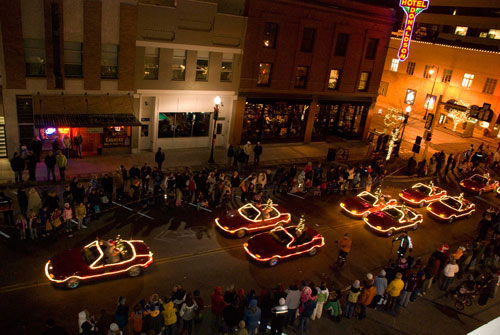Downtown Fargo: Fargo, North Dakota

Summary
Once a rough and rowdy frontier town, Downtown Fargo is a cosmopolitan neighborhood that embodies a live-work-play philosophy. Over the past decade, innovative programs and partnerships have turned blighted buildings into apartments, condominiums, and a boutique hotel, providing the clientele for trendy restaurants, distinctive shops, and chic galleries. Pedestrians, cars, buses, and bicycles form a unique, multimodal tapestry, and the expansion of North Dakota State University has injected a younger demographic into downtown.
Designated Area
Roughly 100 blocks, downtown Fargo's eastern border is the Red River of the North with University Drive the western border, 7th and 9th Avenues North the northern border, and 3rd and 6th Avenues South the southern border.
More than $100 million in public and private investment since 1999 has focused on downtown's 39-block renaissance zone.
Planning Excellence
Downtown Fargo includes open spaces and recreational areas. The 45-acre Island Park is a gathering place and home to the neighborhood's swimming pool. When it snows, kids flock to the Dike East recreation area on the banks of the Red River of the North, where an earthen levee serves as a popular sledding hill. The free Fargo Skate Park challenges even the most advanced skateboarder.

The neighborhood hosts a variety of events throughout the year including the Holiday Lights Parade sponsored by the Downtown Community Partnership. Photo courtesy Daren Dobson.
Commitment to Planning and Revitalization
- Having spurred 180 projects, the renaissance zone exempts new development from property and income taxes for five years; commercial tenants receive five-year state income tax exemption. Building values in the zone have risen 110 percent — from $103 million in 2000 to more than $218 million in 2009. Among the $93 million in renaissance zone projects is the $18-million Cityscapes Plaza, a newly opened retail and student-housing project
- Broadway, the zone's commercial and retail spine, received $10-million facelift, including more pedestrian-friendly street design — decorative pavers in street and sidewalks, ornate light poles, iron street furniture, bicycle racks, trees, planting beds
- Many strategic investments recommended in 2002 Downtown Fargo Redevelopment Framework Plan implemented; plan updated in 2007
Bicyclist, Pedestrian, and Transit Rider Friendly
- Broadway is downtown's official Bicycle/Pedestrian Safety Zone, although bicyclists are welcome on all streets; Broadway features a shared-path, also on-street bike racks and bike lockers; 4,000 North Dakota State University students attending classes downtown significantly boost number of bicyclists
- Sidewalks and tree-lined streets welcome pedestrians; mostly low-rise buildings are human in scale and many feature ground-floor retail with commercial and owner-occupied residential above. Ordinances changed to encourage outdoor dining, street performers and sidewalk marketing; promotional activities — including art walk and "cruising night" — dramatically increased pedestrian activity
- Metro Area Transit ridership doubled during past five years to nearly 1.7 million; nine of transit service's 23 routes pass through Downtown Fargo; new downtown circulator in 2010 proposed budget; will optimize use of remote parking locations

The neighborhood's public art adds to its unique sense of place. Photo courtesy Robert C. Stein.
Historic Preservation
- Added to the National Register in 1983, the 14-block Downtown Fargo Historic District contains 147 contributing properties plus an additional 16 properties listed individually; most structures built after 1893 when fire destroyed the central core. The few commercial buildings that survived, most were in Gothic or Italianate styles; much of post-fire construction done in Classical Revival style using higher-quality materials
- State income tax credits, amounting to 25 percent of the cost of renovation, are available to property owners within renaissance zone; federal tax incentives apply to renovations within historic district
- City's storefront and downtown rehabilitation program uses federal Community Development Block Grant funds to provide 50 percent matching grant (up to $15,000) to refurbish building exteriors; Fargo Historic Preservation Commission reviews renovations
Housing Options
- Downtown quiet zone went into effect in 2007, eliminating dozens upon dozens of ear-splitting train whistles each day from two sets of railroad tracks that pass through downtown
- Single-family detached housing in downtown neighborhood located on perimeter; more than 60 condominium and apartment projects — both adaptive reuse and infill development — have been completed in the renaissance zone
- Of the 559 units of deeply subsidized housing in the downtown, 249 are conventional public housing units; five buildings containing 195 units under the federal Section 8 program and another 115 units of affordable housing are located in four buildings and made available through the Low Income Housing Tax Credit program; ratio of affordable to marketplace units is in balance
Environment
- Downtown Fargo is home to four buildings with green roofs, including new public library that opened in April
- North Dakota's first LEED certified building is in downtown; erected in 1903, the 70,000-square-foot building was rehabbed and upgraded by university to house Visual Arts, Architecture and Landscape Architecture Departments
- Fargo transit buses use a blend of up to 20 percent biodiesel fuel to decrease costs and reduce emissions and odor; city uses energy-efficient and long-lasting LED traffic signals

Successful revitalization of downtown Fargo now brings large crowds during special events. Photo courtesy Jed Pahan.


